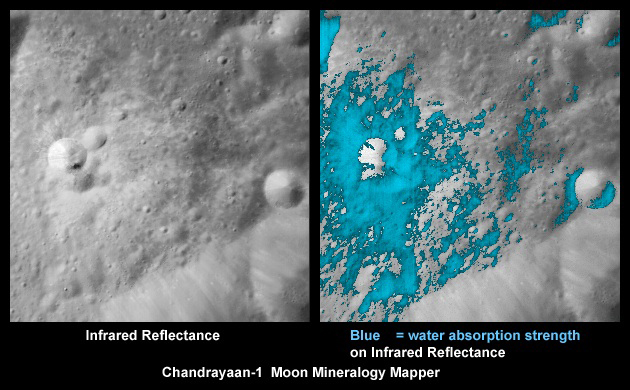A three-pronged model put forward recently in the “science advances review” is highly gaining the attention of astrophysicists. What is the importance of this model and the puzzle that had been solved by this? Let’s take a look at this exciting news.
Everyone knows, mars is known as the red planet due to the presence of iron on its surface. But for rust to be present on any surface there should be three basic things to facilitate the rusting process. The presence of liquid water, absence of hydrogen, and the presence of oxygen on the surface of the astrophysical object. Only then the rust form of iron, that is hematite, could exist. Even though these three conditions fail to exist for our little moon, there are traces of hematite present on the lunar surface.
It was identified and verified by Dr.Shuai Li of the University of Hawaii, while analyzing the data obtained from the Moon Mineralogy Mapper instrument, or M3 ( made by NASA’s Jet Propulsion Laboratory in Southern California) present on the Indian Space Research Organization’s Chandrayaan-1 orbiter. The data from 2008 were observed and the signature of hematite on the surface was identified by him. This lead to a contradiction in existing assumptions and now researchers are trying to solve this puzzle. First, let’s see why it is so, then take a peek into the model proposed by the researchers.
Moon has no atmospheric layer surrounding it, indicating the absence of oxygen. Also, the surface is dry showing a lack of liquid water. There are solar winds that have hydrogen in it. These are continuously coming from the sun towards the moon and the earth. The moon lacks its own magnetic field for protection from the wind, so in this way, the hydrogen reaches the surface of the moon. Hydrogen is a reducer whereas for hematite to form we need oxidizers which could reduce the electrons present in the surface. So technically speaking, all three factors required for the formation of rust is not present in the moon. Then what could potentially explain the presence of the signature spectra of hematite? This is called the metal mystery.
According to Li “It’s very puzzling, The Moon is a terrible environment for hematite to form in.” So he consulted the JPL scientists Abigail Fraeman and Vivian Sun to help poke at M3’s data and confirm his discovery of hematite. They also identified and supported his findings proving the presence of hematite. Moon’s poles have different compositions than the rest of the body and also polar spectra showed iron littered rocks on the surface.

Credits: ISRO/NASA/JPL-Caltech/Brown University/USGS
The three points of the model put forward by the scientists have the key to unlock this mystery.
First of all, earth has a magnetic field of its own that pulls from one side and has a tail towards other ends. This field is able to carry oxygen from the surface of the earth towards the moon. Also, the moon was much closer to earth previously and is rifting apart from it with time so at that time more oxygen might have transported to the surface. It could explain why the hematite is present more on the side of the moon facing the earth. In 2007, Japan’s Kaguya orbiter discovered that oxygen from Earth’s upper atmosphere can hitch a ride on this trailing magnetotail, as it’s officially known, travelling 239,000 miles (385,00 kilometres) to the Moon.

Secondly, the hydrogen from the solar wind is also blocked by the magnetic layer of the earth and almost 99% is cut away. So when the moon is not facing the sun during its lunar cycle, hydrogen reaching it would be low and during these small periods like windows, hematite could form.
Finally, there are citations of liquid water on the surface of the moon inside the craters but still, the presence of hematite surrounding those regions is low so the researchers tried to study the liquid water present on the surface of the moon. Fast-moving dust particles could collide with molecules on the surface and airborne water could be formed. During these impacts the heat so released could help in the further increase of oxidation rate.

So in short during just the right moments – namely, when the Moon is shielded from the solar wind and oxygen is present – a rust-inducing chemical reaction could occur. This data could also help explain another mystery: why smaller quantities of hematite are also forming on the far side of the Moon, where the Earth’s oxygen shouldn’t be able to reach it. According to scientists, more data is needed to carry the study forward. Newer inventions and techniques which could help probe the surface in detail could help in the study.
“ I think these results indicate that there are more complex chemical processes happening in our solar system than have been previously recognized,” Sun said. “We can understand them better by sending future missions to the Moon to test these hypotheses.”
Journal reference : NASA
Read an Article about the Moon and it’s Craters- Moon In Our Cam & The Craters We Spotted








